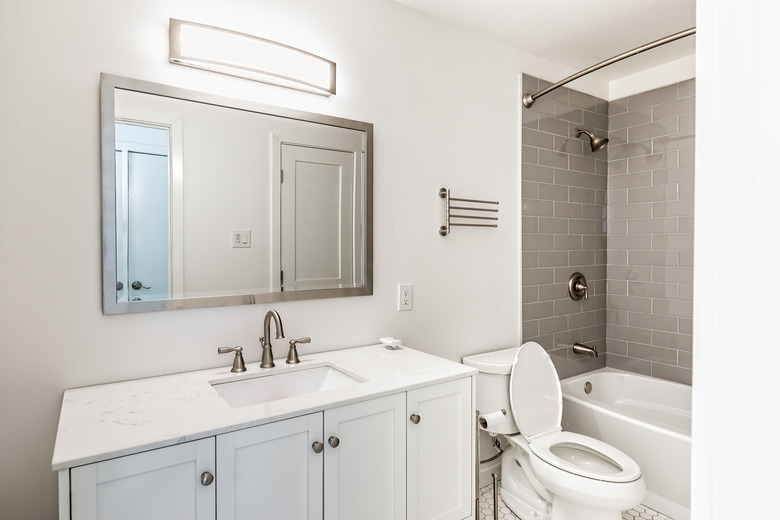How To Use Plastic Bead Board As A Shower Surround
We may receive a commission on purchases made from links.
Plastic bead board is an effective mold-resistant product that is used as a shower surround. It is a durable exterior product that is made of PVC and has the appearance of wainscoting. You can use plastic bead board as a shower surround. Less expensive than tile and more durable than thin plastic inserts, the texture adds visual appeal to your shower and increases the value of your home.
Things Needed
Prepare the Walls
1. Put on Protective Gear
Put on safety goggles, gloves, dust mask and other protective gear. Open windows and turn on the bathroom fan.
2. Remove the Plumbing Fixtures
Remove faucet handles, spigot and shower head. Set aside for cleaning before reinstallation.
3. Protect the Tub
Protect the tub with plastic sheeting. Secure it to the tub with tape.
4. Remove the Existing Surround
Remove existing shower wall surround or tile. Put the tile in buckets to easily remove them from the bathroom.
5. Scrape Off the Caulk
Scrape off all caulk with a heavy plastic spackle blade. Avoid damaging the underlying surface.
6. Check for Mold
Check for mold. If mold is present consider replacing any moldy drywall and/or wood. Use a solution of one part bleach and one part water to spray any visible mold on surfaces that will not be removed. Scrub with a stiff bristle brush and allow to air dry.
Install Green Board Drywall
Install Green Board Drywall
Install green board drywall, commonly known as green board if wall boards are to be replaced. It is a moisture-resistant drywall product that will not grow mold or mildew. Green board is strongly recommended to be used instead of cement board or drywall behind the plastic bead board as mold and mildew cannot grow on this construction-grade material.
1. Measure the Walls
Measure each section of the shower surround and walls. Transfer the measurements to the green board.
2. Cut the Green Board
Cut pieces of green board to fit so edges will line up with existing framing. Mark where each piece will be cut and lay a straight edge on the cut line. Use the utility knife to create a deep score in the Green E-Board. Push down on one side of the green board to break the piece off.
3. Mark the Pipe Locations
Measure and mark placement in the piece of green board for pipes. Use a drill and hole saw the same size as the pipes to drill holes so the pipes will fit through the green board.
4. Attach the Green Board
Screw the green board pieces to framing with drywall screws.
5. Apply Joint Compound
Apply a thin coat of joint compound where the pieces of green board meet on walls and corners. Allow to dry according to the manufacturer's directions before proceeding.
Install Plastic Bead Board
1. Cut the Plastic Bead Board
Starting from a back corner, measure the shower area, mark each piece and cut to fit with a circular saw.
2. Install the First Piece
Install the first piece tight to the corner. Apply a thick line of panel adhesive to the back of the bead board. Check with a level to be sure the edge is plumb.
3. Nail Into Place
Nail into place using 1 1/2-inch-long finishing nails; nail at an angle from the tongue towards the board. Use a nail set to inset the nail head so the next piece will fit snugly on the tongue. Space nails 6 inches apart along the edge of the tongue, with one at the top and one at the bottom to firmly secure the ends.
4. Fit the Boards Together
Install subsequent pieces by running a thin bead of caulk in the groove and sliding the groove onto the tongue. Repeat the process of gluing and nailing each board into place.
5. Measure and Mark the Corners
Measure the width of the area the end piece must fit at corners and mark the top, bottom and middle. Use a straight edge to draw a line on the plastic bead board, then cut with a hand saw. Apply a larger amount of panel adhesive on end pieces, then gently push the piece onto the groove of the previous piece and push into place. Carefully nail on the edge to hold in place.
6. Prepare the End Pieces
Measure and mark the end pieces, especially the pipe locations. Use a drill with a hole saw to cut out the holes for the pipes to fit through the bead board.
7. Press the Board Into Place
Apply panel adhesive as before and press the plastic bead board into place. Caulk around the pipes, the bottom of the plastic bead board and in the corners.
8. Add the Trim
Cut matching trim with a mitered edge and nail into place around the bottom and top of the plastic bead board. Caulk around the bottom of the trim.
9. Install the Corner Trim
Cut manufactured corner trim to size. Glue and install on corners of the shower surround.
10. Reinstall the Fixtures
Clean and reinstall the plumbing fixtures.
